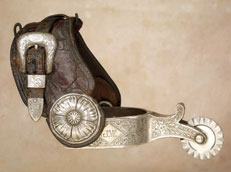
Nathaniel Thwing
| Birth place or City of origin: | Industry |
| State of origin: | MN |
| Last known City: | Portland |
| Last known State: | OR |
| Start/Birth date: | |
| Death/End date: |
Nathaniel Thwing
John G Thwing
Nathaniel Thwing makes his first appearance in early Portland, as a harness and saddle maker in
1870, according to Scott’s HISTORY OF PORTLAND. I would say that in fact he arrived in
Portland much earlier than that, about the year 1864. What is not clear is if he was a master
skilled saddle maker, or a harness and collar maker.
Nathaniel was the youngest of two brothers born to Nathaniel Thwing [Sr.] and Joanna Perkins
in Industry, Maine. The parents were natives of Woolwich, Maine. The eldest was John
Greenough Thwing, born 17 Aug. 1836, and Nathaniel was born 31 Dec. 1837. Both must have
been trained in the leather working arts, as they make a joint appearance in San Francisco,
California in 1863, living together at 1131 Clay St. and operating a business as “harness and collar
makers” under the single name of John G. Thwing. Nathaniel is listed only as a harness maker.
A City Directory of San Francisco for the following year (1864), makes an entry for John G.
Thwing working alone, making leather collars at 801 Battery St. He was also living alone. It
seems reasonable to assume that these men made their way to the west coast in order to profit
from a skill learned in the years following the peak of the California Gold Rush. They would
have been only 13 and 14 in 1849, a bit young to have followed the initial rush, but not impossible
in an era when young cabin boys were employed by the many Clipper ships making their way
around the Horn.
In 1866, a collar shop was opened in Portland by J.G. (John G.) at 146 Front St. The natural
conclusion would be that he moved north to Portland, as many tradesmen did, but the name of
John Thwing only appears in that first year. After that, Nathaniel Thwing is listed as a saddler at
various addresses on Front Street, from 81 to 116. Marriage records show that Nathaniel Thwing
married Clara B. Hall, in Portland, Oregon, 6 April 1867. The Special Federal Census of 1870,
lists the business as having one or two employees, $1000 in capital, and in the business of saddles
and jobbing 200 products in the prior 12 months. $5000 in saddlery, $1000 in jobbing. After 1871,
the Thwing name ceases to appear in Portland business circles.
It is not known which direction he may have drifted to in the years between 1872 and 1880.
Interestingly, an Annie Thwing is listed in a Directory for Portland, residing at 384 E. Park, as a
“domestic” in 1887.
An interesting excerpt from the 1876-78 period follows, much from the book VISIBLE BONES
(Nisbet 2003):
In May 1876, Benjamin Coplen (1843-1912), a homesteader on Hangman (present Latah) Creek
south of Spokane, discovers huge, mysterious bones in a bog near his spring. These fossils and
others unearthed by neighbors are eventually identified as those of the Columbian mammoth.---
The five Coplen brothers, familiar with farm livestock, at least could match most of the bones
with those of known animals, but could not identify the much larger creatures from which they
must have come. Of all the bones uncovered, the most puzzling were the long, curved objects
that the Coplens assumed to be huge horns. Soon the brothers went on the road to exhibit some
of their finds in such towns as Colfax, Walla Walla, and Dayton, where they attracted crowds and
much newspaper coverage.--- Meanwhile, Ben Coplen’s neighbors, William and Thomas
Donahoe, drained a spring on their own property and brought up, among other bones, a huge
skull. They exhibited their finds at the Walla Walla County Fair.
48
After the Walla Walla Fair, the Donahoe Brothers sold their fossil bones which they had
“ballyhooed” to the crowds. For $700, they were purchased by “traveling agents” and partners
Falkner, Mitchell, and Nathaniel Thwing. Thwing seemed to be the promoter of the tour. He
packed up the fossils and booked passage on a steamboat to Portland, by way of The Dalles. In
good Carnival fashion he overstated the truth a bit, and the crowds came in. His plans included
a winter tour in California. He made a stop in Salem, 10 Oct. 1876. The Coplens competed and
handled their specimens personally, but Nathaniel Thwing and a Walla Walla associate, John
Hancock displayed the Donahoe fossils. They reached San Francisco in November, 1876.
This clip of information is included here because of the colorful and probable history of this
person’s entry into the Circus, carnival, side-show, or “Snake Oil “ trade.
[The author knows of no leather maker marks for this person]
[Dates of operation for this business in Portland, 1866 – circa 1871]
___________________________________________________
References:
San Francisco City Directories, 1863 and 1864 on line. http://www.sfgenealogy.com/sf/1863/248.gif
http://www.sfgenealogy.com/sf/1864/290.gif
http://www.sfgenealogy.com/sf/1863/215.gif
http://www.sfgenealogy.com/sf/1864/252.gif
1870 Federal Census, Portland, Multnomah Co., Oregon
1880 Federal; Census Index, Oregon
1863-1881 City Directories, microfilm, State Library of Oregon, Salem
1882 City Directory, Portland, Oregon
1887 City Directory, Portland, Oregon
Multnomah County Marriage Index, Vol 2, p79 (Thwing/Hall)
http://worldconnect.rootsweb.com/cgi-bin/igm.cgi?op=GET&db=jonesthomas&id=1230 (Thwing genealogy)
http:// www.historylink.org/essays/output.cfm?file_id=7512
Nisbet, Jack. Visible Bones: Journeys Across Time in the Columbia River Country. Sasquatch Books 2003
Federal Mortality Schedule and Special Agricultural and Industrial Census for 1870. Portland, Oregon.
Microfilm, at the Genealogical Forum of Oregon.
Research by Richard and Dorothy Egan
If problems with website occur, please contact the webmaster. Site designed by Ireland Graphic Design.

